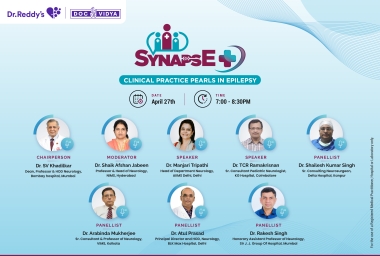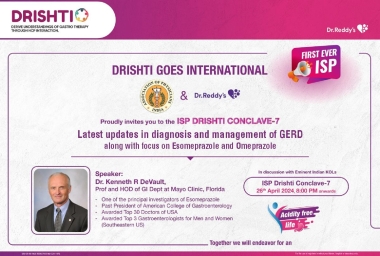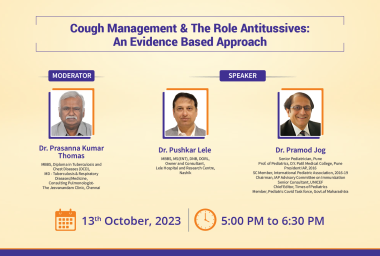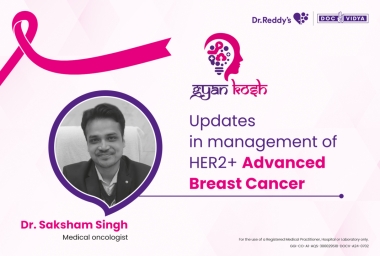CoughXpert - Symptom checker
Welcome to our symptom checker tool! In just three minutes, you can gain valuable insights into your health concerns.

Medshorts

Sugemalimab plus chemotherapy improved progression-free survival and overall survival in advanced ESCC patients
A recent study demonstrated that the utilization of sugemalimab alongside chemotherapy significantly improved progression-free survival and overall survival in treatment-naïve individuals with advanced esophageal squamous cell carcinoma (ESCC). This study’s findings were published in the journal, Nature medicine.
A total of 540 adults, ranging in age from 18 to 75 years, who were diagnosed with locally advanced, unresectable, recurrent or metastatic ESCC and had not undergone any previous systemic treatment, were enrolled in this multicenter, double-blinded, randomized, phase 3 trial. The patients were randomly assigned in a 2:1 ratio to receive either sugemalimab, an anti-PD-L1 antibody at a dose of 1,200 mg or placebo every 3 weeks for a maximum period of 24 months. Additionally, all the randomized patients underwent chemotherapy consisting of cisplatin (80 mg m-2 on day 1) and 5-fluorouracil (800 mg m-2 day-1 on days 1-4) every 3 weeks for a maximum of six cycles. The study assessed both progression-free survival and overall survival outcomes.
With a median follow-up of 15.2 months, the extension of progression-free survival showed statistical significance when comparing sugemalimab plus chemotherapy to placebo plus chemotherapy (median 6.2 months vs 5.4 months). Additionally, overall survival was better with sugemalimab plus chemotherapy when compared to placebo plus chemotherapy (median 15.3 months vs 11.5 months). There was a notably higher objective response rate (60.1% vs 45.2%) observed with sugemalimab plus chemotherapy compared to placebo plus chemotherapy.
Thus, it can be concluded that the combination of sugemalimab and chemotherapy led to a notable extension in both progression-free survival and overall survival among treatment-naïve individuals with advanced ESCC.

Sugemalimab plus chemotherapy improved progression-free survival and overall survival in advanced ESCC patients
A recent study demonstrated that the utilization of sugemalimab alongside chemotherapy significantly improved progression-free survival and overall survival in treatment-naïve individuals with advanced esophageal squamous cell carcinoma (ESCC). This study’s findings were published in the journal, Nature medicine.
A total of 540 adults, ranging in age from 18 to 75 years, who were diagnosed with locally advanced, unresectable, recurrent or metastatic ESCC and had not undergone any previous systemic treatment, were enrolled in this multicenter, double-blinded, randomized, phase 3 trial. The patients were randomly assigned in a 2:1 ratio to receive either sugemalimab, an anti-PD-L1 antibody at a dose of 1,200 mg or placebo every 3 weeks for a maximum period of 24 months. Additionally, all the randomized patients underwent chemotherapy consisting of cisplatin (80 mg m-2 on day 1) and 5-fluorouracil (800 mg m-2 day-1 on days 1-4) every 3 weeks for a maximum of six cycles. The study assessed both progression-free survival and overall survival outcomes.
With a median follow-up of 15.2 months, the extension of progression-free survival showed statistical significance when comparing sugemalimab plus chemotherapy to placebo plus chemotherapy (median 6.2 months vs 5.4 months). Additionally, overall survival was better with sugemalimab plus chemotherapy when compared to placebo plus chemotherapy (median 15.3 months vs 11.5 months). There was a notably higher objective response rate (60.1% vs 45.2%) observed with sugemalimab plus chemotherapy compared to placebo plus chemotherapy.
Thus, it can be concluded that the combination of sugemalimab and chemotherapy led to a notable extension in both progression-free survival and overall survival among treatment-naïve individuals with advanced ESCC.


Sugemalimab plus chemotherapy improved progression-free survival and overall survival in advanced ESCC patients
A recent study demonstrated that the utilization of sugemalimab alongside chemotherapy significantly improved progression-free survival and overall survival in treatment-naïve individuals with advanced esophageal squamous cell carcinoma (ESCC). This study’s findings were published in the journal, Nature medicine.
A total of 540 adults, ranging in age from 18 to 75 years, who were diagnosed with locally advanced, unresectable, recurrent or metastatic ESCC and had not undergone any previous systemic treatment, were enrolled in this multicenter, double-blinded, randomized, phase 3 trial. The patients were randomly assigned in a 2:1 ratio to receive either sugemalimab, an anti-PD-L1 antibody at a dose of 1,200 mg or placebo every 3 weeks for a maximum period of 24 months. Additionally, all the randomized patients underwent chemotherapy consisting of cisplatin (80 mg m-2 on day 1) and 5-fluorouracil (800 mg m-2 day-1 on days 1-4) every 3 weeks for a maximum of six cycles. The study assessed both progression-free survival and overall survival outcomes.
With a median follow-up of 15.2 months, the extension of progression-free survival showed statistical significance when comparing sugemalimab plus chemotherapy to placebo plus chemotherapy (median 6.2 months vs 5.4 months). Additionally, overall survival was better with sugemalimab plus chemotherapy when compared to placebo plus chemotherapy (median 15.3 months vs 11.5 months). There was a notably higher objective response rate (60.1% vs 45.2%) observed with sugemalimab plus chemotherapy compared to placebo plus chemotherapy.
Thus, it can be concluded that the combination of sugemalimab and chemotherapy led to a notable extension in both progression-free survival and overall survival among treatment-naïve individuals with advanced ESCC.

Impact of intensified androgen blockade in patients with high-risk biochemically relapsed castration-sensitive prostate cancer
A recent study showed that intensified AR blockade for a finite period extends prostate-specific antigen progression-free survival (PSA-PFS) while maintaining a manageable safety profile, without negatively impacting the time needed for testosterone recovery. This study’s findings were published in the Journal of clinical oncology.
The PRESTO trial was a randomized, open-label, phase III study that involved 503 patients diagnosed with biochemically recurrent prostate cancer (BRPC) and PSA doubling time of 9 months or less. Patients were randomly divided into one of three groups in a 1:1:1 ratio. These groups consisted of a 52-week treatment course with ADT (androgen-deprivation therapy) control, ADT combined with apalutamide, or ADT combined with apalutamide and AAP (abiraterone acetate plus prednisone). The primary endpoint of the trial was to evaluate PSA-PFS, which was defined as having a serum PSA level exceeding 0.2 ng/mL after the completion of the assigned treatment.
The median PSA level was determined to be 1.8 ng/mL (IQR, 1.0-3.6). During the initial planned interim analysis, it was observed that both experimental groups exhibited a significant prolongation in PSA-PFS when compared to the control group (median, ADT + apalutamide was 24.9 months vs 20.3 months for ADT alone; median, ADT + apalutamide + AAP was 26.0 months vs 20.0 months for ADT alone). There was no notable difference in the median time for testosterone recovery across the different treatment arms.
The above results demonstrated that the use of intensified AR blockade for a finite period has been found to PSA-PFS while maintaining a manageable safety profile and not interfering with testosterone recovery time. Consideration should be given to adding apalutamide to androgen deprivation therapy in high-risk BRPC patients.

Impact of intensified androgen blockade in patients with high-risk biochemically relapsed castration-sensitive prostate cancer
A recent study showed that intensified AR blockade for a finite period extends prostate-specific antigen progression-free survival (PSA-PFS) while maintaining a manageable safety profile, without negatively impacting the time needed for testosterone recovery. This study’s findings were published in the Journal of clinical oncology.
The PRESTO trial was a randomized, open-label, phase III study that involved 503 patients diagnosed with biochemically recurrent prostate cancer (BRPC) and PSA doubling time of 9 months or less. Patients were randomly divided into one of three groups in a 1:1:1 ratio. These groups consisted of a 52-week treatment course with ADT (androgen-deprivation therapy) control, ADT combined with apalutamide, or ADT combined with apalutamide and AAP (abiraterone acetate plus prednisone). The primary endpoint of the trial was to evaluate PSA-PFS, which was defined as having a serum PSA level exceeding 0.2 ng/mL after the completion of the assigned treatment.
The median PSA level was determined to be 1.8 ng/mL (IQR, 1.0-3.6). During the initial planned interim analysis, it was observed that both experimental groups exhibited a significant prolongation in PSA-PFS when compared to the control group (median, ADT + apalutamide was 24.9 months vs 20.3 months for ADT alone; median, ADT + apalutamide + AAP was 26.0 months vs 20.0 months for ADT alone). There was no notable difference in the median time for testosterone recovery across the different treatment arms.
The above results demonstrated that the use of intensified AR blockade for a finite period has been found to PSA-PFS while maintaining a manageable safety profile and not interfering with testosterone recovery time. Consideration should be given to adding apalutamide to androgen deprivation therapy in high-risk BRPC patients.


Impact of intensified androgen blockade in patients with high-risk biochemically relapsed castration-sensitive prostate cancer
A recent study showed that intensified AR blockade for a finite period extends prostate-specific antigen progression-free survival (PSA-PFS) while maintaining a manageable safety profile, without negatively impacting the time needed for testosterone recovery. This study’s findings were published in the Journal of clinical oncology.
The PRESTO trial was a randomized, open-label, phase III study that involved 503 patients diagnosed with biochemically recurrent prostate cancer (BRPC) and PSA doubling time of 9 months or less. Patients were randomly divided into one of three groups in a 1:1:1 ratio. These groups consisted of a 52-week treatment course with ADT (androgen-deprivation therapy) control, ADT combined with apalutamide, or ADT combined with apalutamide and AAP (abiraterone acetate plus prednisone). The primary endpoint of the trial was to evaluate PSA-PFS, which was defined as having a serum PSA level exceeding 0.2 ng/mL after the completion of the assigned treatment.
The median PSA level was determined to be 1.8 ng/mL (IQR, 1.0-3.6). During the initial planned interim analysis, it was observed that both experimental groups exhibited a significant prolongation in PSA-PFS when compared to the control group (median, ADT + apalutamide was 24.9 months vs 20.3 months for ADT alone; median, ADT + apalutamide + AAP was 26.0 months vs 20.0 months for ADT alone). There was no notable difference in the median time for testosterone recovery across the different treatment arms.
The above results demonstrated that the use of intensified AR blockade for a finite period has been found to PSA-PFS while maintaining a manageable safety profile and not interfering with testosterone recovery time. Consideration should be given to adding apalutamide to androgen deprivation therapy in high-risk BRPC patients.

Evaluation of the diagnostic accuracy of point-of-care ultrasound for pediatric distal forearm fractures
According to a recent study, clinician-performed point-of-care ultrasound proved to be more precise in diagnosing clinically nondeformed distal forearm injuries in children and adolescents compared to clinician-interpreted radiographic imaging. The findings of this study were published in the journal, Annals of emergency medicine.
This was an open-label, multicenter, diagnostic randomized controlled trial where 270 participants were enrolled. Eligible patients were randomly assigned to undergo initial imaging either through point-of-care ultrasound conducted by an emergency department (ED) clinician or through radiography (135 randomized to each imaging group). The primary outcome was the treating clinician's diagnostic accuracy in comparison to the reference standard diagnosis. The reference standard diagnosis was determined retrospectively by a panel of experts, which included an emergency physician, pediatric orthopedic surgeon, and pediatric radiologist. This panel thoroughly reviewed all imaging and follow-up data.
At the end of the study, it was observed that in the point-of-care ultrasound group, 132 (97.8%) participants were accurately diagnosed by ED clinicians, while in the radiograph group, 112 (83.0%) participants received correct diagnoses. Point-of-care ultrasound demonstrated superior accuracy in detecting "buckle" fractures (AD=18.5%) and "other" fractures (AD=17.1%).
Thus, it can be concluded that clinician-performed point-of-care ultrasound demonstrated superior accuracy in diagnosing clinically nondeformed distal forearm injuries in children and adolescents compared to clinician-interpreted radiographic imaging in the ED.

Evaluation of the diagnostic accuracy of point-of-care ultrasound for pediatric distal forearm fractures
According to a recent study, clinician-performed point-of-care ultrasound proved to be more precise in diagnosing clinically nondeformed distal forearm injuries in children and adolescents compared to clinician-interpreted radiographic imaging. The findings of this study were published in the journal, Annals of emergency medicine.
This was an open-label, multicenter, diagnostic randomized controlled trial where 270 participants were enrolled. Eligible patients were randomly assigned to undergo initial imaging either through point-of-care ultrasound conducted by an emergency department (ED) clinician or through radiography (135 randomized to each imaging group). The primary outcome was the treating clinician's diagnostic accuracy in comparison to the reference standard diagnosis. The reference standard diagnosis was determined retrospectively by a panel of experts, which included an emergency physician, pediatric orthopedic surgeon, and pediatric radiologist. This panel thoroughly reviewed all imaging and follow-up data.
At the end of the study, it was observed that in the point-of-care ultrasound group, 132 (97.8%) participants were accurately diagnosed by ED clinicians, while in the radiograph group, 112 (83.0%) participants received correct diagnoses. Point-of-care ultrasound demonstrated superior accuracy in detecting "buckle" fractures (AD=18.5%) and "other" fractures (AD=17.1%).
Thus, it can be concluded that clinician-performed point-of-care ultrasound demonstrated superior accuracy in diagnosing clinically nondeformed distal forearm injuries in children and adolescents compared to clinician-interpreted radiographic imaging in the ED.


Evaluation of the diagnostic accuracy of point-of-care ultrasound for pediatric distal forearm fractures
According to a recent study, clinician-performed point-of-care ultrasound proved to be more precise in diagnosing clinically nondeformed distal forearm injuries in children and adolescents compared to clinician-interpreted radiographic imaging. The findings of this study were published in the journal, Annals of emergency medicine.
This was an open-label, multicenter, diagnostic randomized controlled trial where 270 participants were enrolled. Eligible patients were randomly assigned to undergo initial imaging either through point-of-care ultrasound conducted by an emergency department (ED) clinician or through radiography (135 randomized to each imaging group). The primary outcome was the treating clinician's diagnostic accuracy in comparison to the reference standard diagnosis. The reference standard diagnosis was determined retrospectively by a panel of experts, which included an emergency physician, pediatric orthopedic surgeon, and pediatric radiologist. This panel thoroughly reviewed all imaging and follow-up data.
At the end of the study, it was observed that in the point-of-care ultrasound group, 132 (97.8%) participants were accurately diagnosed by ED clinicians, while in the radiograph group, 112 (83.0%) participants received correct diagnoses. Point-of-care ultrasound demonstrated superior accuracy in detecting "buckle" fractures (AD=18.5%) and "other" fractures (AD=17.1%).
Thus, it can be concluded that clinician-performed point-of-care ultrasound demonstrated superior accuracy in diagnosing clinically nondeformed distal forearm injuries in children and adolescents compared to clinician-interpreted radiographic imaging in the ED.


























